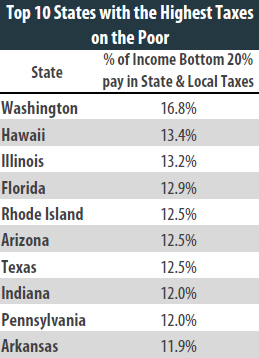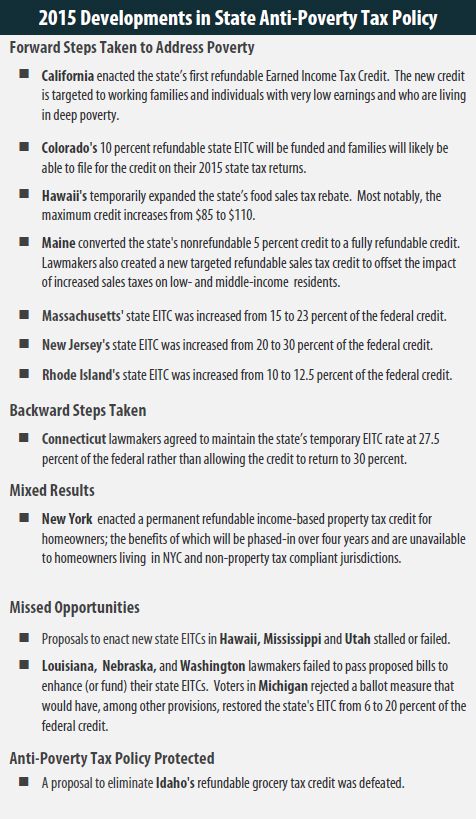The U.S. Census Bureau released data in September showing that the share of Americans living in poverty remains high. In 2014, the national poverty rate was 14.8 percent – statistically unchanged from the previous year.1 However, the poverty rate remains 2.3 percentage points higher than it was in 2007, before the Great Recession, indicating that recent economic gains have not yet reached all households and that there is much room for improvement. The 2014 measure translates to more than 46.7 million – more than 1 in 7 – Americans living in poverty. Most state poverty rates also held steady between 2013 and 2014 though twelve states experienced a decline.2
The Supplemental Poverty Measure (SPM) released alongside the official measure, demonstrates that the tax code can be used as an effective poverty-fighting tool.3 The federal EITC and refundable portion of the Child Tax Credit alone, for example, decreased the supplemental poverty rate from 18.4 to 15.3 percent for everyone. And, thanks in large part to those credits, the supplemental poverty rate for children is actually lower than their official poverty rate (16.7 compare to 21.5 percent).
Astonishingly, tax policies in virtually every state make it harder for those living in poverty to make ends meet. When all the taxes imposed by state and local governments are taken into account, every state imposes higher effective tax rates on poor families than on the richest taxpayers. Despite the unlevel playing field states create for their poorest residents through existing policies, many state policymakers have recently proposed (and in some cases enacted) tax increases on the poor under the guise of “tax reform,” often to finance tax cuts for their wealthiest residents and profitable corporations.
State and local tax systems typically make things harder for families living in poverty. A 2015 ITEP report, Who Pays? A Distributional Analysis of the Tax Systems in All 50 States, found that the poorest twenty percent of Americans paid on average 10.9 percent of their incomes in state and local taxes. Middle-income taxpayers didn’t fare much better, paying an average of 9.4 percent of their incomes toward those taxes. But when it comes to the wealthiest one percent, ITEP found they paid an average of just 5.4 percent of their incomes in state and local taxes.
The fact is that nearly every state and local tax system takes a much greater share of income from middle- and low-income families than from the wealthy. This “soak the poor” strategy pushes low-income families further into poverty and increases the likelihood that they will need to rely on safety net programs. From a state budgeting perspective, this strategy also doesn’t yield much revenue compared to modest taxes on the rich.
There is a better approach. Just as state and local tax policies can push individuals and families further into poverty, there are tax policy tools available that can help them move out of poverty. In most states, a true remedy to improve state tax fairness would require comprehensive tax reform. Short of this, lawmakers should use their states’ tax systems as a means of providing affordable, effective and targeted assistance to people living in or close to poverty in their states.
This report presents a comprehensive overview of anti-poverty tax policies, surveys tax policy decisions made in the states in 2015, and offers recommendations that every state should consider to help families rise out of poverty. States can jump-start their anti-poverty efforts by enacting one or more of four proven and effective tax strategies to reduce the share of taxes paid by low- and moderate-income families: state Earned Income Tax Credits, property tax circuit breakers, targeted low-income credits, and child-related tax credits.
|
STATE LAWMAKERS LIFT UP EITCS AS POVERTY FIGHTING MEASURES IN 2015 Lawmakers from across the aisle came together in five states this year to champion Earned Income Tax Credits (EITCs) as vital tools to address poverty and provide targeted tax cuts to low-income working families. This legislative action was a huge victory for anti-poverty advocates who have largely been fighting proposals to weaken or eliminate the credit in recent years. California became the 27th state (including DC) to enact a new refundable EITC. Massachusetts, New Jersey, and Rhode Island lawmakers boosted the value of their state credits and Maine lawmakers converted the state’s nonrefundable EITC to a fully refund- able credit. State EITCs are invaluable in providing affordable, effective and targeted tax breaks to low-income working families who are hit hardest by state tax systems. While the fact remains that every state tax system is upside down, the advancements in state EITCs in 2015 will help improve tax fairness in the five states where lawmakers improved or enacted credits. |
STATE TAX STRATEGIES FOR REDUCING POVERTY
Refundable Earned Income Tax Credits
The federal Earned Income Tax Credit (EITC) is widely recognized as an effective anti-poverty strategy. It was introduced in 1975 to provide targeted tax reductions to low-income workers and also to reward work and increase incomes.
The federal EITC is administered through the personal income tax. To encourage greater participation in the workforce, the EITC is based on earned income, such as salaries and wages. For example, for each dollar earned up to $13,870 in 2015, families with three children will receive a tax credit equal to 45 percent of those earnings, up to a maximum credit of $6,242. Because the credit is designed to provide tax relief to the working poor, there are income limits that restrict eligibility for the credit. Families continue to be eligible for the maximum credit until income reaches $18,110 (or $23,620 for married-couple families). Above this income level, the value of the credit is gradually reduced to zero and is unavailable when family income exceeds the maximum eligibility level. The credit is entirely unavailable to families with three or more children earning more than $47,747 if the head of household is single and $53,267 if married. For taxpayers without children, the credit is less generous: the maximum credit is $503 and singles earning more than $14,820 (or $20,340 for married couples without children) are ineligible.
In 2015, more than half of the states (twenty-seven states including the District of Columbia) offer state Earned Income Tax Credits based on the federal EITC. Calculating a state EITC as a percentage of the federal credit makes the credit easier for state taxpayers to claim (since they have already calculated the amount of their federal credit) and easier for state tax administrators to monitor. However, states vary dramatically in the generosity of their credits. The credit provided by the District of Columbia amounts to 40 percent of the federal credit (100 percent for childless workers), while seven states will have credits worthless than 10 percent of the federal credit in 2015. In 2013, North Carolina became the first state to allow their EITC to expire. California enacted a new refundable EITC in 2015 targeted to families living in deep poverty.
Refundability is especially important in ensuring that deserving families get the full benefit of the state EITC. Refundable credits do not depend on the amount of income taxes paid: if the credit amount exceeds your income tax liability, the excess amount is given as a refund. Thus, refundable credits are useful in offsetting the regressive nature of sales and property taxes, and can provide a much needed income boost to help families pay for basic necessities. In 2015, all but three states (Delaware, Ohio and Virginia), with EITCs offer a fully refundable credit.
State EITCs generate bipartisan support because they are easily administered and relatively inexpensive. However, EITCs are most generous to families with children. Policymakers should be aware that the EITC does little to benefit seniors and low-income individuals without children because it was designed to specifically help families with children. There are other tax provisions offered by states, like enhanced personal exemptions or standard deductions, that are available to elderly taxpayers. The EITC itself can also be modified to reach otherwise excluded groups. For example, policymakers in Washington, DC enhanced the district’s EITC for childless workers in 2014. President Obama has proposed a similar policy at the federal level, and there are now multiple bills pending in Congress and a handful of states to implement such a change. These recent developments reinforce the importance of linking state EITC eligibility rules to the federal program, so that any federal expansions are immediately passed on to the states.
2015 EITC Developments in the States
• California lawmakers enacted the state’s first refundable Earned Income Tax Credit. The new credit is targeted to working families and individuals with very low earnings and who are living in deep poverty. The credit is based on the federal credit, but has its own income eligibility parameters, phase out rules, and maximum credits. The new credit fully phases out for single, childless workers earning $6,580 or more and for married couples with two or more children earning $13,870 or more.
• Colorado lawmakers enacted a permanent 10 percent refundable state EITC in 2013 contingent on state revenues exceeding specified targets. Those targets were met in 2015, so Colorado working families will likely be able to file for the credit on their 2015 tax returns.
• Connecticut lawmakers agreed to maintain the state’s temporary EITC rate at 27.5 percent of the federal rather than allowing the credit to return to 30 percent.
• As part of a larger tax reform package, Maine lawmakers converted the state’s 5 percent nonrefundable EITC to a fully refundable credit.
• Massachusetts’ lawmakers approved an increase in the state’s refundable EITC from 15 to 23 percent of the federal credit.
• Michigan voters rejected a ballot initiative in May that among other things would have restored the state’s EITC from 6 to 20 percent of the federal credit. Lawmakers have also explored the option of eliminating the credit altogether to help pay for a transportation spending package.
• New Jersey lawmakers increased the state’s refundable EITC from 20 to 30 percent of the federal credit. Until 2010, the credit had been 25 percent, so this change is a historical move forward.
• Rhode Island lawmakers increased the state’s refundable EITC from 10 to 12.5 percent of the federal credit.
• Proposals to enact new state EITCs in Hawaii, Mississippi and Utah stalled or failed. Louisiana, Nebraska and Washington lawmakers failed to pass proposed bills to enhance (or fund) their state EITCs.
Recommendation: To help alleviate poverty, lawmakers and advocates in states with EITCs should consider increasing the percentage of the existing credit, making the credits fully refundable, and improving the benefits for childless workers. Those in states without a credit should consider introducing a generous and refundable EITC tied to the federal credit.
|
IMPORTANCE OF REFUNDABILITY The hallmark of a truly effective low-income credit is that it is refundable. This means that if the amount of the credit exceeds the amount of personal income tax you would otherwise owe, you actually get money back. Refundability is a vital feature in low- income credits because for most fixed-income families, sales and property taxes take a much bigger bite out of their wallets than the personal income tax does. Refundable credits on income tax forms are the most cost-effective mechanism for partially offsetting the effects of regressive consumption taxes on low-income families. |
Property Tax Circuit Breaker for Homeowners & Renters
States employ a wide variety of mechanisms to reduce the amount of property taxes that low- and moderate income families pay, though they vary significantly in effectiveness. A property tax circuit breaker is the only property tax reduction program explicitly designed to reduce the property tax burden on those low-income taxpayers hit hardest by the tax. Its name reflects its design: circuit breakers protect low-income residents from a property tax “overload”, just like electric circuit breakers prevent electricity surges in our homes. When a property tax bill exceeds a certain percentage of a taxpayer’s income, the circuit breaker offsets property taxes in excess of this “overload” level.
In 2015, 15 states and DC offer property tax circuit breaker programs that target tax reductions to lowincome families who also owe significant property taxes relative to their incomes. Another 15 states provide property tax credits to some low-income families; however, the credits in those states are only based on income—these credits cut-off eligibility based on income, but do not include a provision requiring property taxes to exceed a set percentage of income to qualify for the credit (see Appendix B).
The most effective and targeted property tax credits are circuit breaker programs made available to all lowincome taxpayers, regardless of age, and are also extended to renters. Because it is generally understood that renters pay property taxes indirectly in the form of higher rents, many states now extend their circuit breaker credit to renters as well. The calculation is typically the same as the one used for homeowners, with the exception that renters must assume that their property tax bill is equal to some percentage of their rent. Renters in Maryland for instance, use 15 percent of their rent as their assumed property tax in calculating their circuit breaker credit. For a circuit breaker program to be successful, an effective outreach campaign is necessary.
2015 State Property Tax Circuit Breaker Developments
• New York lawmakers enacted a permanent refundable income-based property tax credit for homeowners; the benefits of which will be phased-in over four years. Homeowners with incomes of $275,000 and below will receive a rebate for a sliding-scale percentage of the tax savings due to their School Tax Relief (STAR) exemption. The credit is unavailable to New York City homeowners and others who live in property tax jurisdictions that do not comply with the state’s property tax cap.
Recommendation: State lawmakers and advocates interested in reducing the property taxes paid by low-income homeowners and renters should consider introducing a robust circuit-breaker program. States with circuit breaker programs only available to older adults or homeowners should consider expanding the program to low-income homeowners and renters of all ages.
|
STATES WITH THE GREATEST NEED FOR IMPROVEMENT Every state could stand to improve its tax policies toward low- and moder- ate- income families. However, some states have a stronger need to consider the reforms outlined in this report. The chart to the right shows the 10 states with the highest state and local taxes on the poor as a share of income ac- cording to ITEP’s 2015 Who Pays? report. Washington State, which does not have an income tax, is the highest-tax state in the country for poor people. In fact, when all state and local sales, excise and property taxes are tallied up, Washington’s poor families pay 16.8 percent of their total income in state and local taxes. Compare that to neighboring Idaho and Oregon, where the poor pay 8.5percent and 8.1 percent, respectively, of their incomes in state and local taxes—far less than in Washington. Hawaii, which relies heavily on consumption taxes, ranks second in its taxes on the poor, at 13.4 percent. Illinois—a state with a flat income tax rate —taxes its poor families at a rate of 13.2 percent, ranking third in this dubious distinction. |
 |
Targeted Low-Income Tax Credits
Because the Earned Income Tax Credit is targeted to low-income working families with children, it typically offers little or no benefits to older adults and adults without children. Thus, refundable low-income credits are a good complementary policy to state EITCs (see Appendix C).
Eleven states offer targeted income tax credits to reduce (or zero out) low-income families’ personal income tax contributions. For example, Ohio offers a nonrefundable credit that ensures that families with incomes less than $10,000 aren’t subject to the income tax. Kentucky offers a nonrefundable credit based on family size to ensure that families at or below the poverty level aren’t subject to state income taxes. Making these targeted low-income credits refundable would increase their effectiveness for low-income families.
Seven states offer an income tax credit to help offset the sales and excise taxes that low-income families pay. Some of the credits are specifically intended to offset the impact of sales taxes on groceries. These credits are normally a flat dollar amount for each family member, and are available only to taxpayers with income below a certain threshold. They are usually administered on state income tax forms, and are refundable— meaning that the full credit is given even if it exceeds the amount of income tax a claimant owes.
Refundability is crucial because it allows low-income credits to be used by taxpayers who have little or no income tax liability but pay a substantial amount of their income in sales taxes. For example, Idaho offers a refundable credit for each Idahoan and their dependents to offset grocery taxes even if taxpayers aren’t subject to the income tax. Kansas lawmakers eliminated their state’s refundable grocery tax credit in 2012 but enacted a new, less-effective nonrefundable credit in 2013.
2015 State Low-Income Tax Credit Developments
• Hawaii lawmakers temporarily expanded the state’s food sales tax rebate. Most notably, the maximum credit increases from $85 to $110.
• A bill that would have eliminated Idaho’s refundable grocery tax credit to pay for corporate and personal income rate reductions failed. A similar bill that would have eliminated the state’s grocery tax credit to pay for exempting groceries from the sales tax base also failed.
• Maine lawmakers enacted a new refundable sales tax credit, the Sales Tax Fairness Credit, for low- and middle-income Maine residents. The credit amount is tied to family size and income and gradually phases out as income increases. For example, a married couple with 2 children with income below $40,000 would receive the maximum credit of $225 and the credit is unavailable to families with incomes of $52,000 and above.
Recommendation: State lawmakers and advocates committed to making sure taxes don’t push families further into poverty should create refundable, targeted low-income credits especially to help offset regressive sales and excise taxes. In states where these credits already exist, lawmakers should act to enhance them, such as by making them refundable.
|
STATES PRAISED AS “LOW-TAX” STATES ARE OFTEN HIGH TAX STATES FOR FAMILIES LIVING IN POVERTY Annual state and local data from the Census Bureau is often used to rank states as “low” or “high” tax states based on taxes collected as a share of state personal income. But focusing on a state’s overall tax revenues overlooks the fact that taxpayers experience tax systems very differently. In particular, the poorest 20 percent of taxpayers pay a greater share of their income in state and local taxes than any other income group in all but 15 states . And, in every state, low- and moderate-income taxpayers pay significantly more as a share of income than the top 1 percent of taxpayers. The District of Columbia is the only tax system where the poorest residents pay the least as a share if income compared to other residents across the income spectrum No income-tax states like Washington, Texas and Florida do, in fact, have average to low taxes overall. But, can they also be considered “low-tax” states for poor families? Far from it. In fact, these states’ disproportionate reliance on sales and excise taxes make their taxes among the highest in the entire nation on low-income families. The bottom line is that many so-called “low-tax” states are high-tax states for the poor, and most do not offer a good deal to middle-income families either. Only the wealthy in such states pay relatively little. |
Child-Related Tax Credits
Child Tax Credits: Federal income tax law allows taxpayers to claim a $1,000 income tax credit for each dependent child under 17 years of age. The credit amount is gradually phased out for high income families. A portion of the child tax credit is refundable for low-income families.
Four states currently offer a much smaller version of the child tax credit for qualifying families (Colorado will join this list contingent on Congress passing a law to allow states to force out-of-state online retailers to collect and remit sales taxes-see Appendix D). These per-child credits are an important anti-poverty strategy, especially if they are refundable and limited by income. The credits are offered beyond the extra dependent exemptions or exemption credits that most states offer families. For example, New York offers a $100 refundable child tax credit for qualifying families.
Child and Dependent Care Credits: Low and middle-income working parents increasingly spend a significant portion of their income on child care. The federal government allows a nonrefundable income tax credit to help offset child care expenses. In 2015, single working parents (and two-earner married couples) with children less than 12 years of age can claim a credit to partially offset up to $6,000 of child care expenses; lowincome taxpayers can receive a credit of up to 35 percent of these expenses. The credit percentage gradually falls for higher-income taxpayers. This “sliding scale” approach helps to target tax relief somewhat more effectively to low-income taxpayers, but making the credit refundable would help those parents and children most in need.
The majority of the 22 states (including DC- See Appendix D) that offer a credit for child care expenses model their state credit on the federal credit. For example, Georgia allows taxpayers to take 30 percent of their federal child and dependent care credit as a nonrefundable child care credit. Nebraska takes a slightly different approach, offering both a refundable and a nonrefundable credit depending on a family’s income. The refundable child care credit is calculated as 100 percent of the federal credit for low income filers with incomes under $29,000. Higher earners can claim a nonrefundable credit equal to 25 percent of the federal credit. This approach targets the benefits of the Nebraska credit much more efficiently to low- and middle-income parents than does the federal credit.
2015 Child-Related Tax Credit Developments
• There were no significant changes made to state child-related tax credits in 2015.
Recommendation: State lawmakers and advocates who want to help low-income families with children should consider increasing the value of existing child credits, making them refundable, or introducing a new refundable per child credit. Lawmakers and advocates interested in targeting child and dependent care credits to help families most in need would do well to make their credits refundable and make the credit available only to families with limited incomes.
IMPLEMENTATION: A VITAL STEP
Offering the tax policies described in this report is a necessary step to helping lift families out of poverty, but simply offering these credits is not sufficient. In order to ensure that as many eligible families benefit from these anti-poverty policies as possible, lawmakers should consider how to make the credits more accessible.
A simple design, such as linking a credit to an already established credit (as is the case with state EITCs) is a good place to start. Allowing taxpayers to claim credits on their personal income tax forms (as opposed to filling out a separate form or application at a different time of the year) also increases the likelihood that eligible taxpayers will take advantage of the credits.
Furthermore, policymakers, advocacy groups, and the media must work together to ensure that an effective outreach program is established and adequately funded so that taxpayers are informed about these credits.Outreach programs should be frequently evaluated to improve the effective reach of the tax credits offered.
|
WHICH STATES GET IT (CLOSE TO) RIGHT? The most noticeable features of the least regressive tax states are a highly progressive income tax including targeted tax credits and a lesser reliance on sales and excise taxes. For example: • Vermont’s tax system is among the least regressive in the nation because it has a highly progressive income tax and low sales and excise taxes. Vermont’s tax system is also made more fair by the size of the state’s refundable Earned Income Tax Credit (EITC)—32 percent of the federal credit—and a generous property tax circuit breaker credit. • Delaware’s income tax is not very progressive, but its high reliance on income taxes and low dependence of consumption taxes results in a tax system that is only slightly regressive overall. Similarly, Oregon has a high reliance on income taxes and very low use of consumption taxes. Both states also offer a state EITC. • New York and the District of Columbia each achieve a close-to-flat tax system overall through the use of generous refundable EITC’s and an income tax with relatively high top rates and limits on tax breaks for upper-income taxpayers. A recent tax reform bill in DC lowered the income tax rate for middle-income earners, increased the standard deduction and personal exemption allowed, and expanded the EITC for childless workers. New York also provides a refundable Child Tax Credit based on the federal program, and both states provide property tax circuit breaker credits. It should be noted that even the least regressive states generally fail to meet what most would consider minimal standards of tax fairness. In each of these states, at least some low- or middle-income groups pay more of their income in state and local taxes than the wealthiest families must pay. |
SUMMARY OF RECOMMENDATIONS
- State lawmakers and advocates in states with EITCs should consider increasing the percentage of the existing credit, making the credits fully refundable, and improving the benefit for childless workers. Those in states without a credit should consider introducing a generous and refundable EITC tied to the federal credit.
- State lawmakers and advocates interested in reducing the property taxes paid by low-income homeowners and renters should consider introducing a robust circuit-breaker program. States with circuit breaker pro- grams only available to older adults or homeowners should consider expanding the program to low-income homeowners and renters of all ages.
- State lawmakers and advocates committed to making sure taxes don’t push families further into poverty should create refundable, targeted low-income credits especially to help offset regressive sales and excise taxes. In states where these credits already exist, lawmakers should act to enhance them, such as by making them refundable.
- State lawmakers and advocates who want to help low-income families with children should consider in- creasing the value of existing child credits, making them refundable, or introducing a new refundable per child credit. Lawmakers and advocates interested in targeting child and dependent care credits to help families most in need would do well to make their credits refundable and make the credit available only to families with limited incomes.
CONCLUSION
American families living in poverty are in crisis, and many state tax systems across the country do too little to offer the assistance low-income families need. In fact, regressive state tax structures can push families deeper into poverty. State lawmakers have a responsibility to ensure that their state’s tax code does not exacerbate this crisis and should consider using the low-income tax credits outlined in this paper as a means of mitigating poverty in their states. Re- fundable tax credits are effective and time-tested anti-poverty solutions that would also provide additional income to help families pay for food, housing, transportation and other necessities. The reforms discussed in this paper are among the most cost-effective anti-poverty strategies available to state lawmakers.
1 Carmen DeNavas-Walt et al.,“Income, Poverty and Health Insurance Coverage in the United States in 2014,” U.S. Census Bureau, September 16, 2015
2 U.S. Census Bureau, American Community Survery 2014.
3 Short, Kathleen, “The Supplemental Poverty Measure: 2014,” U.S. Census Bureau, September 2015





